Plot
Casimir Fleetwood lives in Merionethshire, North Wales, on a large estate near Cader Idris in the early to mid-eighteenth century and is brought up as an only child. While on the grand tour, he visits his father's old friend, Monsieur Ruffigny, in Switzerland, who is a thinly disguised portrait of Rousseau. While he is there, his father dies, and Ruffigny decides to accompany Casimir back to Wales and tells the story of his life and how he became friends with Casimir's father during the journey. At 45 years old, he marries Mary Macneil, whose family have all died in a shipwreck. Casimir finds it difficult to adjust to married life and his wife is much younger. He invites his distant cousins, Kenrick and Gifford. Casimir is unaware that Gifford's aim is to discredit his brother, and to become Casimir's heir. Mary becomes pregnant by the time the men come to stay, but Casimir imagines she is having an affair with Kenrick, prompted by Gifford's insinuations. Casimir frequently alludes to Othello in his account of this affair. After acting as a go-between for Kenrick and her friend, Louisa Scarborough, Mary is accused of adultery and is divorced by her husband, who goes to France. Kenrick and Casimir arranges to meet Gifford in Paris. As he approaches the city, however, Casimir is set upon by men who drag him from his carriage. Louisa's father arrives, denounces Gifford and reveals that Kenrick rescued Casimir from the attackers and Gifford was the shooter.
Scarborough has proof that Kenrick and Mary are innocent. Casmir forgives Kenrick and is introduced to his baby son. He makes a will, giving his wife his possessions, Kenrick an estate worth £18,000, and says he plans to live in the Pyrenees on £400 a year. Mary arrives and they are reconciled. Gifford is executed in France as a highwayman and a swindler. Kenrick and Louisa marry.
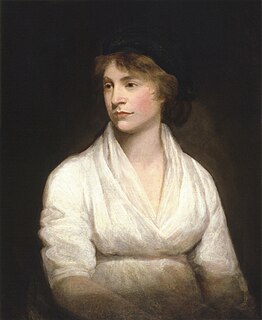
Mary Wollstonecraft was an English writer, philosopher, and advocate of women's rights. Until the late 20th century, Wollstonecraft's life, which encompassed several unconventional personal relationships at the time, received more attention than her writing. Today Wollstonecraft is regarded as one of the founding feminist philosophers, and feminists often cite both her life and her works as important influences.

Pride and Prejudice is an 1813 romantic novel of manners written by Jane Austen. Though it is mostly called a romantic novel, it can also be considered a satirical book. The novel follows the character development of Elizabeth Bennet, the dynamic protagonist of the book who learns about the repercussions of hasty judgments and comes to appreciate the difference between superficial goodness and actual goodness.

Rhiannon is a major figure in the Mabinogi, the medieval Welsh story collection. She appears mainly in the First Branch of the Mabinogi, and again in the Third Branch. She is a strong-minded Otherworld woman, who chooses Pwyll, prince of Dyfed, as her consort, in preference to another man to whom she has already been betrothed. She is intelligent, politically strategic, beautiful, and famed for her wealth and generosity. With Pwyll she has a son, the hero Pryderi, who later inherits the lordship of Dyfed. She endures tragedy when her newborn child is abducted, and she is accused of infanticide. As a widow she marries Manawydan of the British royal family, and has further adventures involving enchantments.
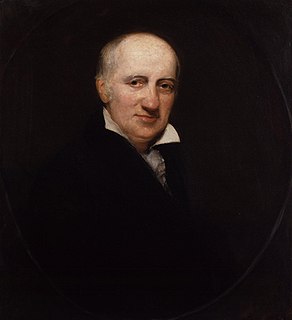
William Godwin was an English journalist, political philosopher and novelist. He is considered one of the first exponents of utilitarianism and the first modern proponent of anarchism. Godwin is most famous for two books that he published within the space of a year: An Enquiry Concerning Political Justice, an attack on political institutions, and Things as They Are; or, The Adventures of Caleb Williams, an early mystery novel which attacks aristocratic privilege. Based on the success of both, Godwin featured prominently in the radical circles of London in the 1790s. He wrote prolifically in the genres of novels, history and demography throughout his life.

Persuasion is the last novel completed by Jane Austen. It was published along with Northanger Abbey at the end of 1817, six months after her death. The novel was published on December 20, 1817, although the title page is dated 1818.
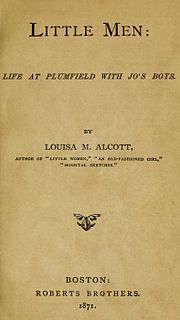
Little Men, or Life at Plumfield with Jo's Boys, is a children's novel by American author Louisa May Alcott (1832–1888), which was first published in 1871 by Roberts Brothers. The book reprises characters from her 1868–69 two-volume novel Little Women, and acts as a sequel, or as the second book in an unofficial Little Women trilogy. The trilogy ends with Alcott's 1886 novel Jo's Boys, and How They Turned Out: A Sequel to Little Men. Alcott's story recounts the life of Jo Bhaer, her husband, and the various children at Plumfield Estate School. Alcott's classic novel has been adapted to a 1934 film, a 1940 film, a 1998 film, a television series, and a Japanese animated television series.

The Duchess of Duke Street is a BBC television drama series set in London between 1900 and 1925. It was created by John Hawkesworth, previously the producer of the ITV period drama Upstairs, Downstairs. It starred Gemma Jones as Louisa Leyton Trotter, the eponymous "Duchess" who works her way up from servant to renowned cook to proprietrix of the upper-class Bentinck Hotel in Duke Street, St. James's, in London.

Wieland: or, The Transformation: An American Tale, usually simply called Wieland, is the first major work by Charles Brockden Brown. First published in 1798, it distinguishes the true beginning of his career as a writer. Wieland is sometimes considered the first American Gothic novel. It has often been linked to Caleb Williams by William Godwin. Godwin's influence is clear, but Brown's writing is unique in its style. Wieland is often categorized under several subgenres other than gothic fiction, including horror, psychological fiction and epistolary fiction, which are listed at Project Gutenberg.

Firelight is a 1997 period romance film written and directed by William Nicholson and starring Sophie Marceau and Stephen Dillane. Written by William Nicholson, the film is about a woman who agrees to bear the child of an anonymous English landowner in return for payment to resolve her father's debts. When the child is born, the woman gives up the child as agreed. Seven years later, the woman is hired as a governess to a girl on a remote Sussex estate, whose father is the anonymous landowner. Filmed on location in Firle, England and Calvados, France, the film premiered at the Deauville American Film Festival on 14 September 1997. Firelight was Nicholson's first film as a director.

The Deluge is a historical novel by the Polish author Henryk Sienkiewicz, published in 1886. It is the second volume of a three-volume series known to Poles as "The Trilogy," having been preceded by With Fire and Sword and followed by Fire in the Steppe. The novel tells a story of a fictional Polish–Lithuanian Commonwealth soldier and noble Andrzej Kmicic and shows a panorama of the Commonwealth during its historical period of the Deluge, which was a part of the Northern Wars.

Mary: A Fiction is the only complete novel by 18th-century British feminist Mary Wollstonecraft. It tells the tragic story of a female's successive "romantic friendships" with a woman and a man. Composed while Wollstonecraft was a governess in Ireland, the novel was published in 1788 shortly after her summary dismissal and her decision to embark on a writing career, a precarious and disreputable profession for women in 18th-century Britain.
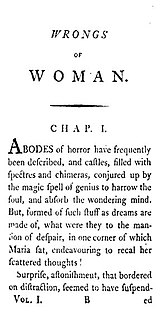
Maria: or, The Wrongs of Woman is the 18th-century British feminist Mary Wollstonecraft's unfinished novelistic sequel to her revolutionary political treatise A Vindication of the Rights of Woman (1792). The Wrongs of Woman was published posthumously in 1798 by her husband, William Godwin, and is often considered her most radical feminist work.
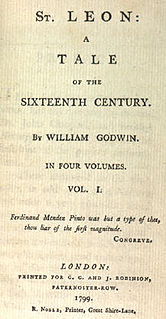
St. Leon: A Tale of the Sixteenth Century (1799) is eighteenth-century British philosopher William Godwin's second novel.

Frankenstein; or, The Modern Prometheus is an 1818 novel written by English author Mary Shelley. Frankenstein tells the story of Victor Frankenstein, a young scientist who creates a sapient creature in an unorthodox scientific experiment. Shelley started writing the story when she was 18, and the first edition was published anonymously in London on 1 January 1818, when she was 20. Her name first appeared in the second edition, which was published in Paris in 1821.

History of a Six Weeks' Tour through a part of France, Switzerland, Germany, and Holland; with Letters Descriptive of a Sail Round the Lake of Geneva and of the Glaciers of Chamouni is a travel narrative by the English Romantic authors Mary Shelley and Percy Bysshe Shelley. Published anonymously in 1817, it describes two trips taken by Mary, Percy, and Mary's stepsister, Claire Clairmont: one across Europe in 1814, and one to Lake Geneva in 1816. Divided into three sections, the text consists of a journal, four letters, and Percy Shelley's poem "Mont Blanc". Apart from the poem, preface, and two letters, the text was primarily written and organised by Mary Shelley. In 1840 she revised the journal and the letters, republishing them in a collection of Percy Shelley's writings.

Celestina is an eighteenth-century English novel and poet Charlotte Smith’s third novel. Published in 1791 by Thomas Cadell, the novel tells the story of an adopted orphan who discovers the secret of her parentage and marries the man she loves. It is a courtship novel that follows the typical Cinderella plot while still commenting on contemporary political issues.
Francis Johnson Webb was an American novelist, poet, and essayist from Philadelphia, Pennsylvania. His novel, The Garies and Their Friends (1857), was the second novel by an African American to be published, and the first to portray the daily lives of free blacks in the North.

Mary Wollstonecraft Shelley was an English novelist who wrote the Gothic novel Frankenstein; or, The Modern Prometheus (1818), which is considered an early example of science fiction. She also edited and promoted the works of her husband, the Romantic poet and philosopher Percy Bysshe Shelley. Her father was the political philosopher William Godwin and her mother was the philosopher and feminist activist Mary Wollstonecraft.

Hobomok, a Tale of Early Times. is a novel by the nineteenth-century American author and human rights campaigner Lydia Maria Child. Her first novel, published in 1824 under the pseudonym "An American," was inspired by John G. Palfrey's article in the North American Review. It is set during the late 1620s and 1630s. Among other themes, it relates the marriage of a recently immigrated white American woman, Mary Conant, to the eponymous Native American and her attempt to raise their son in white society.
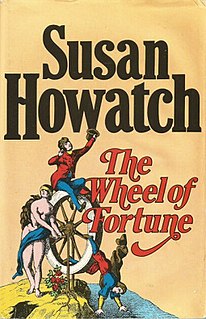
The Wheel of Fortune (1984) is a novel by Susan Howatch and recounts the trials and tribulations of a fictitious British family, the Godwins, who appear to be part of the minor aristocracy.


















